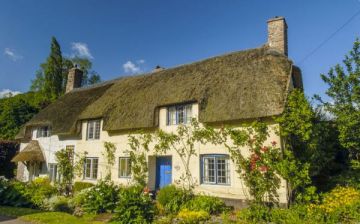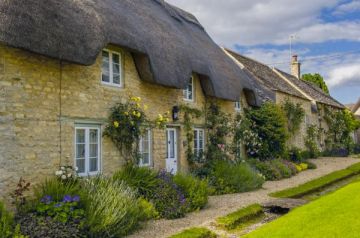CONTENT
- Wells, Somerset
- The Gunpowder Plot
- UK Travel tips and news
Welcome friends, its time to put the kettle on, settle into a comfortable armchair, and enjoy the best of Britain with Britain Update. But before you do, please take the time to forward this newsletter to someone who loves Britain as much as you do.
David Ross, Publisher
UK Destinations
Wells
Somerset, England
What makes a city a city? Technically, the presence of a cathedral makes a town into a city, so that qualifies the quiet Somerset backwater of Wells as a city. Yet thinking of Wells as a city is misleading, for this beautiful home of the Bishops of Bath and Wells has much more of a rural town or very large village about it. With only about 10,000 residents, Wells is the smallest city in England.
The highlight of a visit to Wells is the magnificent cathedral. Wells Cathedral is one of the architectural highlights of Britain, replete with intricate Gothic carvings, a unique scissors vault to brace the building against shifting medieval foundations, and a marvellous Chapter House.
Wells is named for ... wells. In this case, the freshwater wells that rise up in the gardens of the Bishop's Palace. The wells have been a place of worship for millennia, long before Christianity came to the area. There was a Roman mausoleum on the site, and a 7th-century church built by King Ine.
More about Wells ...
Related: Somerset Travel Guide | Tourist Information Centres
Heritage
The Gunpowder Plot
With Bonfire Night (November 5) just around the corner, I thought it would be a good idea to take a look at the origins of this popular festival. On the evening of November 5, people gather throughout Britain to light bonfires, burn effigies of "guys", and set off fireworks. Though today the festival is more an excuse for a good time than anything else, the origins of the festival are far more serious, and go back almost 400 years to the Gunpowder Plot of 1605.
The Gunpowder Plot was an attempt to kill James I, King of England. Catholic conspirators led by Robert Catesby placed kegs of gunpowder in the cellars of the Parliament Buildings on the night of November 4, 1605. They planned to ignite the gunpowder the following day when James, his eldest son, Prince Henry, and Queen Ann attended the opening of Parliament the following day. One of the conspirators, Guy Fawkes, was deputised to stay with the gunpowder and ignite it at the opportune moment.
Read the full story of the Gunpowder Plot.
Travel Tips and News
Rochester's Dickensian Christmas
On December 7th & 8th the historic city of Rochester, in Kent, comes alive with the celebration of the "Dickensian Christmas.' Members of The Dickens Fellowship, The City of Rochester Society, and many other's join in and dress up in Victorian costume and parade the streets of Rochester and the Castle gardens.
Highlights include Christmas carolling, handbell ringers, the Cathedral Choir, a craft fair in the Castle gardens, ice skating, traditional cooking and guided tours of the City. For full details visit http://www.city-of-rochester.org.uk
London Marks Queen Elizabeth I Anniversary
The 400th anniversary of the death of one of England's most powerful monarchs will be marked with a major London exhibition and a range of events around the country next year.
A jewelled ring taken from the finger of Queen Elizabeth I on her death-bed in 1603 is one of the star exhibits of "Elizabeth" at the National Maritime Museum, Greenwich (May 1 - September 14). The exhibition represents the greatest collection of personal items, paintings and Elizabeth-related exhibits ever assembled: many of them never previously on public display. It takes place close to the site of the 'Virgin Queen's' birthplace, the Palace of Placentia.
Other events planned include historical re-enactments at the Tower of London and Hampton Court Palace; Elizabethan festivals at numerous English castles and concerts of Tudor music. Events will start in January and run throughout the summer.
Other exhibits at the Greenwich exhibition include the most remarkable collection of rarely seen portraits of Elizabeth; a love letter from Francis, Duke of Anjou; and items relating to Mary Queen of Scots. The National Maritime Museum, Greenwich, open daily (admission charge for exhibition not yet set) Website: http://www.nmm.ac.uk.
More Christmas Festivals
More British cities are entering into the festive spirit this year by holding Christmas markets. These are not only good opportunities to buy unique gifts but also a chance to enjoy festivities and traditions in historic settings. Cathedrals, abbeys, castles - even famous battleships - are the backdrops, and many people dress in period costume.
One of the best-known events is in Lincoln, this year celebrating its 21st Christmas Market (December 5-8) which claims to be Europe's biggest. (Dec. 5 is evening only.) Held in a cobbled square overlooked by its floodlit 12th-century cathedral, more than 200 stalls offer a variety of gifts and produce. http://www.lincoln-info.org.uk.
Durham in north-east England, whose Norman castle and cathedral are a World Heritage Site, will hold its Christmas Festival from Nov. 30 - Dec. 1. The market and entertainment take place in a cobbled market place; there will also be a craft and gift marquee and roving musicians.
Also in the north, York has its St. Nicholas Fayre (Nov. 28 - Dec 1) which has a magical atmosphere including Victorian street stalls and is followed by the Brigantia Craft Fayre (Dec. 7-9). http://www.yuletideyork.com
In the elegant Georgian city of Bath, the Christmas Market has an increased number of stall-holders and runs for ten days from Nov. 28 - Dec. 8. More than 80 wooden chalet stalls are offering their wares and the market site, bordered by Bath Abbey and the Roman Baths, will be festooned with lights: carol singers and strolling players will add to the atmosphere. http://www.visitbath.co.uk
In the Scottish capital Edinburgh, Princes Street Gardens - with its magnificent castle backdrop - is setting for a German-style Christmas market, ice-rink, big wheel and carousel. It's part of an events programme called Edinburgh's Capital Christmas (Nov. 28 - Dec. 24) which also includes a Grand Fantastical Christmas Parade (Dec. 1) which attracted 120,000 spectators last year. http://www.edinburghscapitalchristmas.org
Selkirk, in the Scottish Borders, recalls the days when novelist Sir Walter Scott presided over its sheriff court. "Scott's Selkirk" (Nov. 30 - Dec 1) features craft stalls and varied small shops, with many people in Georgian costume.
One of the most atmospheric settings is on England's south coast. Portsmouth's Historic Dockyard - home of famous battleships such as HMS Victory, has its Festival of Christmas (Nov. 28 - Dec 1). It not only has a traditional shopping village but also a Victorian tavern, festive foods and two hundred performers, many of them in period costume. http://www.christmasfestival.co.uk
Cycling for Softies in Edinburgh
There is a new way to explore Edinburgh, Scotland's historic capital: on a guided bicycle tour. The three-hour, two-wheeled tours are run by Pedal Culture, who can tailor the relaxed and informal rides to individuals' interests. Exploring the city's Old Town and financial district, the twice-daily trips cost ã15 including bike hire, helmet and waterproofs and routes have been carefully designed to avoid hills wherever possible. Website: http://www.pedalculture.com.
Iron Age Treasure in Winchester
A remarkable collection of Iron Age gold jewellery will be on show at Winchester Museum from October 16 to April 27, 2003. It was discovered two years ago by a man with a metal detector in a field near the city. Archaeologists date the pure gold brooches and necklaces at between 70 and 40 BC, and the high quality of the pieces suggest they were worn by Iron Age nobles, or possibly kings and queens, living in the area at the time.
The period is explored further in a new exhibition at the Historic Resources Centre, just north of the city centre, entitled "Ice to Iron - Prehistoric Peoples in Hampshire". The exhibition is open Monday - Friday, admission free.
New Welsh Museum Charts Industrial Revolution
Blaenafon, the South Wales town awarded World Heritage Site status for its key role in the Industrial Revolution, has a new museum telling the story of the town and its people. The Blaenafon Community Heritage and Cordell Museum, in what was originally the town hall, explains the history of the great ironworks, established in 1757, and nearby mines opened 25 years later - when it was realised that coal, rather than wood, could meet the demands of the ironworks. The problem of separating phosphorus from iron was solved with the Bessemer converter at the ironworks in 1876.
Many of the exhibits have been donated by local people, and there are numerous local industrial archaeological artefacts and a huge collection of photographs and books. The museum also has a section devoted to local author Alexander Cordell, including his desk and typewriter. He set several novels in the area, including his best-seller "Rape of the Fair Country", which has been translated into 17 languages.
Nearby attractions include the Big Pit National Mining Museum, where visitors descend 90 metres below ground for a guided tour of the workings by former miners. Until March 31, the Blaenafon museum is open on Mondays, Tuesdays, Thursdays and Saturdays. From April 1 to September 30, it is open daily except Sundays. Admission adult £2, concessions £1.50, family £5.50.
That's all for now. Until next issue, let me remind you that laughter is contagious. Be a carrier.
David Ross, Publisher, Britain Express



